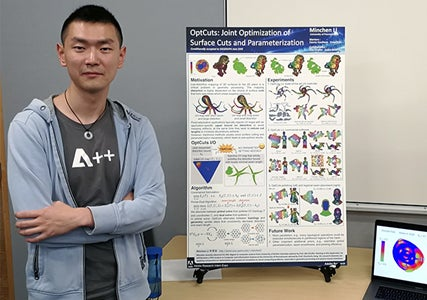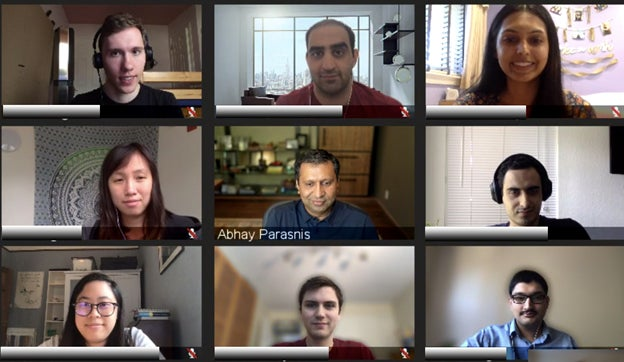Adobe’s virtual summer internship program: fostering brilliant ideas from a distance

It was a summer like no other — especially for the 2020 Adobe interns. While many companies had to put their summer internships on hold during COVID-19, we brought on more than 700 interns virtually across the company, including 135 in Adobe Research — my team of research scientists and engineers who shape early-stage ideas into innovative technologies. It wasn’t easy, but our intern program has always been at the heart of the company’s culture of innovation, so it was crucial to maintain it.
Most summers, the Adobe Research interns join us in person at our offices. We pair them with mentors with shared interests, and from there, after two weeks of discussion and preparation, they propose a three-month research project. If the internship is successful and produces a compelling proof-of-concept demo, then we often continue collaborating with the student when they’re back at their university to prepare the submission of a paper to a conference or journal. In parallel, the researcher may continue to work with the intern and others to bring the idea forward as a candidate product feature, often inviting the intern back for a second internship the following year.
Interns play a central role in our research publication program. In fact, nearly half of the technologies shipped in Adobe products in recent years have come from projects with interns or university collaborators. In the past three years, around 90% of Adobe’s technical publications started as collaborations with universities or students. Last year, more than half of the technology patents our team filed included an intern as an inventor.
For example, Adobe Fresco — an AI-powered mobile painting app that simulates the old-school feeling of real paint and brushes on canvas — was partially sparked by a former research intern (who ended up joining us as a full-time technical research artist). An intern also helped develop Content-Aware Fill for Video in Adobe After Effects, which allows video editors to easily remove video blemishes and other unwanted elements. This tool won five awards at the 2019 NAB Show and the hearts of many post-production video editors.
Interns have also contributed to data intelligence research for Adobe Experience Cloud solutions – such as predictive subject lines in Adobe Campaign, which helps brands optimize email subjects to drive a higher open rate with subscribers – and Smart Layout in Adobe Experience Manager, which automates layout creation for marketing materials.
Beyond the benefits to Adobe, our internship program helps interns see beyond academia to gain an industrial research perspective and learn how customer needs shape product development. This exchange of ideas strengthens the broader conversation between industry and academia, pushing the state of the research forward for all of us.

Former Adobe Research intern Minchen Li shares his work on 3D modeling at an intern showcase.
Giving interns the freedom to explore
One of the guiding principles for the summer program is to step back and let interns try out their ideas. These explorations may lead us toward new areas of research and products we’d never imagined before. Sometimes a project may not make it beyond a proof-of-concept, or the direction of the work may change course based on testing or feedback. However, even when the project doesn’t work out, we often learn a critical insight that informs future research. We also hope the interns learn the fine art of problem selection and customer-motivated problem solving.
Our interns often say that having the autonomy to develop a project, take the initiative for their own research, and try new things makes the program invaluable.
“One of the best things about being an intern is the amount of freedom you get in developing your project. The mentors are always there to help, but the success of your internship is defined by your initiative and the autonomy to try new things.” – Tripti Shukla, 2020 summer intern
Fostering innovation – from a distance
While we were committed to making this summer’s internship program work remotely, it took extra effort to keep ideas flowing and help interns share their thoughts and questions without the typical hallway conversations, group lunches, and whiteboard sessions.
Beyond boosting some of our IT operations, including adding extra security measures and malware protection for interns who had to use personal laptops, we also turned our social events into online gatherings. We invented “virtual donut dates” with the goal of creating some of that magic that usually happens in person – those moments when you discover someone’s research interests dovetail with your own, or that you are looking at two different aspects of the same problem.
Since their research interests were already a match, interns and their mentors made deep virtual connections. We kept our tradition of asking interns plenty of questions and offering suggestions — one way we let them know that their work is noticed and appreciated. And as always, interns were paid and will be credited in all relevant publications and patents.
By the end of the summer, 98% of our interns surveyed across Adobe in North America responded by saying that they felt a sense of belonging at the company. The fact they were able to thrive is a testament to the power of an intriguing research question and an all-ideas-welcome approach.
I also think it gives us a peek at the resilience of the next generation of technology innovators.

Adobe CTO Abhay Parasnis (center) hosting a virtual “coffee talk” with summer interns from Adobe’s Cloud Technology teams, including Adobe Research.
Welcoming a resilient generation — and other silver linings
This summer’s interns amazed us as they took their remote internships in stride. Of course, we shouldn’t be surprised as they’ve grown up in the digital age. They have high expectations for the tools they use, and they bring that same mindset to working remotely. Admittedly, this latest crop of interns taught us as much as we taught them – especially when it came to flexibility and adapting to new digital collaboration tools.
Even when we hit remote-working snags, the challenges were sometimes liberating. For example, when technical limitations caused collaboration tools to falter, we shifted our focus more fully to the ideas and where we could take them. This sometimes even saved us work, leading to a better, more elegant idea.
Looking forward to being together again
Prior to this pandemic, we already had a strong intern program in place, so we tried to keep as much of the spirit of it as we could. It was challenging, but it forced us to think more deeply about what matters for innovation and collaboration, and to better support our teams – no matter where they are.
While it’s too early to say how next summer’s internship program will be structured, we will continue to keep the best of the ideas and tools that emerged while we were remote, no matter how the work environment evolves in the future.
Adobe Research is now seeking interns for spring, summer, and fall of 2021. All internships for 2021 will be remote. Learn more about research internships and find links to apply here.
A version of this story originally posted on Thrive Global.